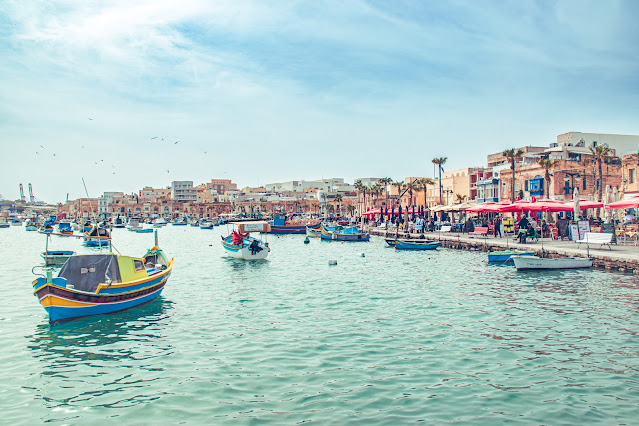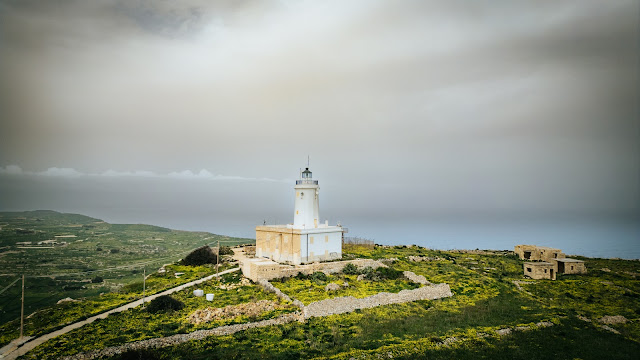Drive My Car
Malta
Last time out we visited Valetta, the capital of Malta and the adjacent Three Cities of Sengeal, Birgu and Cospicua. Now it was time to venture further afield and explore the small island which is only seventeen miles long and nine miles wide. As I mentioned on the previous blog, driving in Malta takes a little bit of getting used to, but once you've mastered the art (of unlearning to drive) you'll find the island relatively easy to get around.
 |
| The 'Luzzu' boats of Marsaxlokk, Malta |
On the south coast is the small village of Wied iz-Zurrieq, where in more clement weather you can jump on a small boat and visit the Blue Grotto. But as we arrived the sea was looking particularly angry and it didn't require the expertise of a ship's captain to ascertain that no boats would be going out today, despite the conflicting bright sunshine. But not to be thwarted, just a two-minute drive away is a vantage point where you can get a great view of the very beautiful natural cave formations.
 |
| The Blue Grotto, Malta |
Continuing west along the coast next up was a place called Pretty Bay in the small seaside town of Birżebbuġa, although I would question the name of the beach as the horizon is dominated by huge ferry port. We were continuing along the coast to find the Delimara Lighthouse which is beyond the huge power station of the same name. It's a very nice black and white striped light and it appears there is a team in the process of restoring the building which is always good to see.
 |
| Delimara Lighthouse, Malta |
A short drive from the lighthouse is the very pretty Marsaxlokk. Although the power station is clearly visible from everywhere, the harbour is beautiful with hundreds of brightly coloured fishing boats called 'luzzu' decorating the seafront. And the harbour is lined with a vast multitude of sea food restaurants selling the catch that the boats bring in. A superb stop for lunch.
 |
| Mdina, the old capital of Malta |
Our next day trip was to visit Mdina, the old capital of Malta in the north of the island. First stop was the St Paul’s Catacombs in Ir-Rabat. The caves were an interesting detour and only a ten- minute walk to the walled city fortress. Mdina is a quiet and tranquil place, almost sealed off from the outside world. The tall stone walls do a sterling of of protecting and cushioning any intrusion from the hustle and bustle of adjacent modern life. The Baroque St Paul's Cathedral is impressive with it's prominent two clocks displaying different times to confuse the Devil.
 |
| Mosta Rotunda, Malta |
 |
| The German bomb of the Mosta Rotunda, Malta |
I should mention that on our day trips we have been feasting on the Maltese delicacy of Pastizzis. These are essentially pasties that predominantly come in two flavours of curried peas and ricotta cheese. These flaky savoury delights are sold from small bakeries and are available pretty much everywhere on the island. They are the perfect lunch fodder and usually cost in the region of 50 cents, so unbelievable value for money.
 |
| Ta'Ġurdan Lighthouse, Gozo |
The archipelago of Maltese islands consists of the mainland, the small island of Comino and Gozo. Any trip to Malta should include a visit to Gozo which is reachable by a fifteen-minute ferry journey from the Cirkewwa Passenger Terminal in the far north of the island, about an hour's drive from Valletta. It's a very simple process to take your car, simply drive on and pay on at the booth on the return journey.
From the ferry we drove to Ta Ġurdan Lighthouse at the highest point on the island. Immediate access to the lighthouse was closed to the public but you'll still get to enjoy the fabulous views across the island. The Maltese do like a church. And from the vantage point you'll see a plethora of domes dotted across the landscape, including the great looking Roman Catholic Basilica at Ta'Pinu.
 |
| Roman Catholic Basilica at Ta'Pinu, Gozo |
In the northwest of the island is Dwejra which is a popular base for boat trips and cliff walking but the weather was bad so that no boat trips were running, although we did see divers venturing out in the inland sea. Despite the freezing winds we did explore the very dramatic shoreline and cliffs.
 |
| The dramatic cliffs at Dwejra, Gozo. |
Another short drive took us to Victoria, the capital of Gozo which has the amazing Cittadella fortress. It's free to explore and the visitor centre makes for an excellent place to visit.
And that sums up our week in colourful Malta. The weather in February was changeable but we still enjoyed lots of sunny days. The brief showers we did encounter didn't curtail any plans although some of the boat trips weren't running. Visiting out of season has the huge benefit of experiencing the island without the large tourist numbers, especially around Valletta which we noticed getting busier when the large cruise ships were in port.
This was our first trip to Malta, and I can start to understand the appeal. It's a relatively short flight from the UK, the food and drink options are excellent and the capital and Three Cities are a real joy to explore on foot. I can see us returning at some point in the future as everyone else seems to do.




Comments
Post a Comment